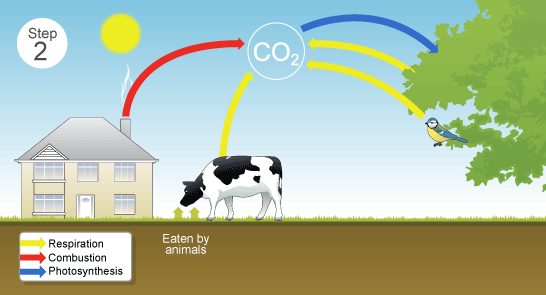Most
of the chemicals that make up living tissue contain carbon. When organisms die
the carbon is recycled so that it can be used by future generations. Four main processes are involved: photosynthesis, respiration, decomposition and combustion.
A. Carbon cycle
Carbon cycle
|
1. Carbon
enters the atmosphere as CO2 from respiration and combustion.
 |
| Credit: BBC Bitesize |
2. CO2 is absorbed by producers to make carbohydrates in photosynthesis.
3. Animals
feed on the plant passing the carbon compounds along the food chain. Most of
the carbon they consume is exhaled as CO2 formed during respiration.
The animals and plants eventually die.
4. The
dead organisms are eaten by decomposers and the carbon in their bodies is
returned to the atmosphere as CO2. In some conditions decomposition
is blocked. The plant and animal material may then be available as fossil fuel
in the future for combustion.
Common misconception
Plants
do not start respiring when they stop photosynthesizing (at night) – they respire
all the time, but during the day there is usually a net intake of CO2 ant
out put of O2.
B. Water cycle
 |
| Water cycle (credit: BBC Bitesize) |
- Energy from the Sun heats the surface of the Earth.
- Plants release water vapour into the air through transpiration.
- Water evaporates from oceans, rivers, lakes and soil.
- The warm, moist air rises because it is less dense.
- Water vapour condenses into water droplets as it cools down, forming clouds.
- Water droplets get bigger and heavier they begin to fall as rain, snow and sleet (precipitation), draining into streams, rivers, lakes and sea.
- Plant root take up water by osmosis.
- In addition, animals lose water to the environment through exhaling and sweating, and in urine and faeces.
Try this
Figure
below shows a diagram of the carbon cycle.
a)
Copy and complete the cycle by filling in boxes A and B. [2 marks]
b) On
your diagram, label with the letter indicated an arrow that represents the
process of:
i)
combustion – C [1 mark]
ii)
decomposition – D [1 mark]
iii)
photosynthesis – P [1 mark]
iv)
respiration – R [1 mark]
Answer
a) A, carbon
compounds in plants.
B, carbon compounds in dead plants and animals.
b)
i) C on arrow between fossil duels
and CO2 in the air.
ii) D
on arrow between box B and CO2 in the air.
iii) P
on arrow between CO2 in the air and box A.
iv) R
on arrow between carbon compounds in animals (or box A) and CO2 in
the air.






This is Immensely useful ,THANKYOU SO MUCH
ReplyDelete